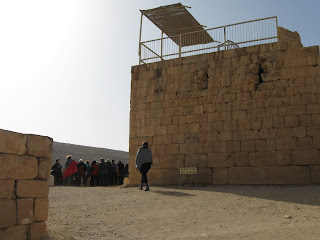Mamshit, ancient Nabatean town, was declared by UNESCO a World Heritage site, in 2005. It is located in the desert, near the modern city of Dimona, not very far from the Dead Sea.
Sign with the name 'Mamshit' , and a map
In antiquity , Mamshit used to be a town of wealthy people who traded in spices, textiles, precious stones/ metals, exotic fragrances - all the things needed for a good life style. The Nabateans of Mamshit also raised arabian horses and that brought them a nice fortune.
The place has become now a National Park with a Visitors' Center, camping facilities, tents, parking spots, etc.. On holidays, the ancient restored market comes to life together with various exciting leisure activities for both adults and kids. There is potential for more excavations, and there's still a lot to be restored on the site.
to the Visitors' Center on the north side of Mamshit
entering the Visitors' Center
souvenir shop, maps, tickets, leaflets
people waiting outside for the guide to go to the ruins
There's a trail leading from the Visitors' Center to the main gate of the ancient city.
The sun was strong, and a light, but stubborn wind, was blowing. I had to take my cap off for fear it'll be carried away by the wind. Nevertheless, it was perfect weather for wandering about in the desert, among the restored houses and streets of Mamshit, for over two hours.
cap in hand
strong sun and naughty wind in the desert
There was a lot to be seen:
- houses with 1- 2 stories, several rooms, a courtyard, staircase, arches; wide streets separating neighboring houses.
- two impessive churches built on the highest points in the city - a western one (the Nilus church) with an intricate mosaic floor, and a eastern one (the Martyrs' church) with small marble pillars.
- a bathouse, a public reservoir, a market, stables (for the arabian horses), frescoes in one of the mansions, a flour mill.
- dams along the bed of the adjacent Mamshit stream, two towerwatches and lookouts overlooking Mamshit, Dimona, the Arava valley.
- structures waiting for reconstruction, and more...
house
street
tower, lookout offering panoramic sights
western Nilus church with a mosic floor
frescoes
frescoes
Remarks:
a. The Nabateans - arab tribes later converted to Cristianity.
b. In the house with the frescoes archeologists found a huge amount of silver coins under a staircase.
c. In the eastern church, archeologists found human bones, probably the bones of those whom they call martyrs.



























































